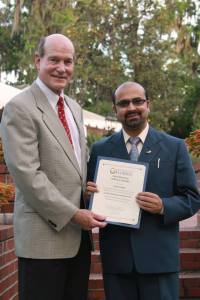Thank you if you read my other story titled “Read Like a Butterfly.” If you did, yes, you’re right, it was not just reading that was challenging when I first joined a U.S. university. Writing was even more so because in the academic culture where I come from, writing was just an annual ordeal. What happened back in South Asia (please do not generalize though) is you only wrote during the final examinations (once a year!). You would neither know who would read your papers nor would you get any feedback. You just got a grade—actually, not even a grade, but “marks” starting from zero, so most students got below 60 out of 100 points.

Doing it only for extremely high-stakes exams made writing the most absurd activity in itself because it was done just to “pass” an examination. You never found out what worked and how to do better next time. It also made writing an act of adventure, but a terrifying and stressful one. If you’re lucky, you pass; if someone didn’t understand your style, you were doomed to failure—and often, even talented students failed. I always felt pity about one of my friends, who often had great ideas and wonderful logical framework in his papers, but unfortunately he failed almost every exam (at least his first attempt) because he had a bad handwriting!
So, most of my previous experiences made writing feel like something to be avoided whenever possible, rather than a part of the learning process, a practical skill that I would want to develop for academic and professional growth. Taking great risks once a year and waiting for months for the results didn’t prepare me at all to do a completely different type of high-stakes writing in graduate school in the U.S.
Once in the U.S., I had to write several papers for every course every semester—not just once a year! Hmm… what did that mean? Well, it was first very, very difficult to start writing. I would often wait for a great idea or vision to begin writing with. When I had to write, due to the pressure of the deadline, I would hysterically write something, but the product would not be as good as I would love to see as my final piece. Since the deadline would be right under the neck, I would have to submit what I had, and, hope for the best. I felt like writing perhaps was not for me! It appeared like I might not be able to continue my graduate journey any longer. But no! That was not an option at this point. I had to do something.
What I did is I took chunks of texts from a few articles from the internet and put them together as my paper. While this looked like a last straw at this critical moment, my inner self was not happy at all. I did have the paper ready but is it going to work? I knew it’s not going to work for two reasons. First, this is just the beginning of my graduate schooling. And second, I wouldn’t be happy even if I completed my degree this by compromising with my own values. Above all, my goal is ambitious—I want to become a researcher in the field of global higher education. I would rather decide to give up than submitting the plagiarized paper. I couldn’t sleep that night. I kept looking for options. There was only one option left–-writing center. I had heard about it but had always thought that it was for the undergrads. Wouldn’t it be embarrassing to tell them I needed help with my writing? Graduate student, I am! But my conscience said, “You’re here to learn after all, Tom! Go ahead and try everything that is at your disposal.” I checked online. Yes! The writing center website said it was not only for graduate students but also for faculty! Cool! I went to bed at 6.00 am after setting an appointment to writing center via the online appointment system.
A sweet lady greeted me at the writing center at 11.00 am that day. I now forget her name but the meaning of her name had something to do with flowers.
“What brings you here today?” asked she. I was a bit nervous and felt awkward and tense as it was hard to say, but she was welcoming.
“I am not happy with my paper,” I handed over the 10-page paper to her. She took a couple minutes to skim over the paper, while I waited for her to get mad at me and probably tell me how foolish I am.
“It looks fine. Why are you not happy?”
“It is only the first two pages that I wrote myself. Rest is copy-pasted from other articles.”
“Okay in that case, I know what you need.” She stood up and went away.
I had no clue whether she was going to call the police, or to bring something to help me (hopefully). My second guess was right. “Here,” she handed me a few green pages neatly stapled together.
“This is a copy of a book chapter. It gives examples on using quoted materials. Using others’ works for your own work is okay. The only thing is, you need to cite properly. This chapter tells you how to do that. Read this at home. But for now I want to you to do something.”
She wanted me to mark whether I agreed, disagreed, or partially agreed with the ideas of all the authors (other than my own ideas) on the paper.
I quickly did so, while she read the first two pages that I had written myself.
“You don’t have any problem in the sentence level,” she said.
“I know how to write a sentence. I have been an English teacher! But the problem is I am not a good writer!” I said under the breath.
“Did you say something?”
“Yes, I said I am not a good writer,” I articulated this for her.
“Well, you can be a good writer. You just need to work on organization and flow of your writing. I have some great tools for you to use. But you need to set another appointment. We’re out of time.”
“Really? But I have my assignment due tomorrow!”
“What? You cannot finish by tomorrow. Ask for an extension, make an excuse! See you in the next appointment!”
Since I felt like I was pretty much on track, I didn’t make excuse. I honestly talked to my professor and told him that I needed an extension. I explained that I had found some good sources lately and that I wanted to write my paper really well. My professor agreed. I got a week’s extension.
I set several appointments with the sweet lady. She gave me one lesson at a time. She gave me lots of photocopied materials to use as reference while writing. Most useful was the list of transition words grouped into several categories such as agreement, opposition, limitation, contradiction, cause, condition, example, emphasis, consequence, conclusion, etc. She also gave me resources and walked me through the process of making an outline and mind-map, showed me how to divide the whole assignment into several parts so that I could work on one part each day. She also gave some practical suggestions such as having another “pair of eyes” to read before you turn in your paper. I jokingly asked how to find a pair of eyes and she also jokingly said, “Go to a church!” That suggestion worked well too. I found a substitute teacher, who agreed to go over my writing to make sure everything I wrote made sense. She would mark if something didn’t and I would rewrite that part. I also reciprocated by helping her with her project report.
Along the way, I learned that writing is not a one-shot enterprise. Writing becomes better and better with every revision and with revision comes a clearer vision! So it is extremely important to set aside regular chunks of time dedicated for writing and then write regularly. I learned not to worry about clarity, grammar, or even ideas while writing the first draft. The key was to revisit the drafts and edit for improving clarity, correctness, flow, and organization. If this sounds familiar to you, you’re lucky! You probably had good teachers who guided you to become a good writer. I did have a wonderful teacher who taught a course on “reading and writing” back home. But what he called reading and writing techniques was actually the “definition” reading and writing. That was pretty much about it.
My experience with writing had kept me away from realizing that writing is a regular activity, a habit, a regular recurrence. Realizing this made me think differently about myself. Whereas I used to think I am not made of the writer-clay, it was liberating to learn that good writing is an outcome of several steps. It is a persistent enterprise like that of a bee’s work. I did have to struggle to find myself in the writing regime. But I did crack the code: What I was doing wrong was that I was handling reading and writing in a wrong way—I was reading like a bee and writing like a butterfly.
What does a butterfly do actually? It dilly-dallies on the flowers that it finds nectar in. Reading is like that – enjoy what you like. But when it comes to writing, you have to act like a bee! As I enjoyed the taste of a good writing, it would also give me an inkling of how I would write something similar myself. I started collecting my favorite words, phrases, expressions, structures, etc. to fit them into my own writing as a bee collects nectar from various flowers and brings back bits and trickles into its honeycomb. With some practice, reading about writing, and imitating the styles of writers I read, I was gradually able to get myself into the regime of writing. I no longer hated my own writing. Though I did not start loving my own writing very soon, learning one strategy after another started giving me a sense that I was moving away from the great impediments that I experienced initially. I started hearing appreciation from my professor about my “good” writing. A shocking sense of joy hit me when I received a strange request from an American colleague before I completed my master’s degree and joined the doctoral program: “Tom, can you review my paper? I love the way you write.”
To cut a long story short, now that I know the nature of the beast, I just “write like a bee.” I focus on details, return to drafts, and take small steps to continue improving it—laboriously and carefully. Yes, there is a lot of labor involved in it, but what has now changed is the feeling that sustains along the process—a tinge of joy.






